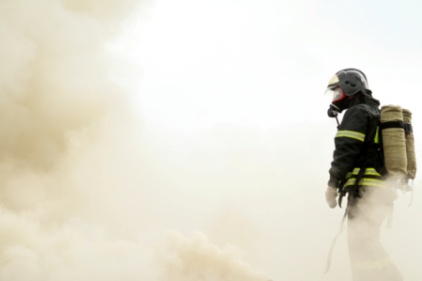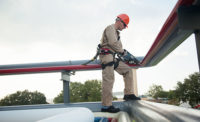Report: Worker protection is key component of homeland security

 The federal government must help train emergency personnel and provide updated safety guidelines so the workers are better protected against hazards such as they faced at the World Trade Center and the Pentagon, according to a public health workshop report by the National Institute of Environmental Health Sciences, a component of the federal National Institutes of Health.
The federal government must help train emergency personnel and provide updated safety guidelines so the workers are better protected against hazards such as they faced at the World Trade Center and the Pentagon, according to a public health workshop report by the National Institute of Environmental Health Sciences, a component of the federal National Institutes of Health.
The report, "Learning from Disasters: Weapons of Mass Destruction Preparedness Through Worker Training," summarizes the findings of an NIEHS Worker Education and Training Program technical workshop that brought together national experts involved in the recent terrorist attacks with those providing the emergency response and cleanup around weapons of mass destruction.
The report says there were many deficiencies in the protection of rescue and other workers that resulted in needless injuries, particularly to eyes and lungs, as they faced the catastrophic structural failures at Oklahoma City and later, on September 11 of last year, at the Pentagon and the World Trade Center. The last "was so massive, extensive in duration and complex that nearly all aspects of our well developed and relatively mature destructive incident response and cleanup operations plans were challenged and, in many cases, found defective in some measure."
Improvements recommended in the report include:
- First-on-the-scene emergency response personnel, such as police and firefighters, need to be trained in and provided with appropriate protective gear, particularly respiratory protection. Major urban centers should identify sources of additional, back-up equipment in the face of a major attack or disaster.
- OSHA should develop safety regulations tailored to the challenges of large terrorist events, and these revised guidelines need to be included in Federal Emergency Management Agency and other response plans. Older, more general guidelines, according to the report, are "essentially useless" in the face of such a mass destruction as that at the Trade Center.
- Firm guidelines for ending the search and rescue phase after 12-15 days are needed. The report says that there is virtually no likelihood of recovery of living victims after that time and that rescue workers cannot function safely after two weeks of 12-hour days. Continued protracted efforts then "begin to take a toll in both physical and mental terms," which leads to increased risk taking, injuries and illness.
- Worker protection standards must be enforced.
- With personnel at the scene of the World Trade Center numbering more than 5,000, command, control, communication and coordination were extremely difficult. These should be improved under a unified command.
The report also recommends a training preparedness initiative by the NIEHS Worker Education and Training Program. For more information on the kinds of follow-up studies being conducted on rescue and other workers and on residents and workers nearby, see press release "HHS Awards" at http://www.niehs.nih.gov/news/newsroom/releases/news-archive/2002/may08/index.cfm.
About the NIEHS WETP
The NIEHS WETP was created in 1987 by Congress as part of the Superfund Program to support the development of a network of non-profit organizations that are committed to protecting workers and their communities by creating and delivering high-quality, peer-reviewed safety and health curricula to target populations of hazardous waste workers and emergency responders. Through NIH extramural grants, WETP supports the development of curricula and training programs throughout the country to help employers meet OSHA requirements under 29 CFR 1910.120, Hazardous Waste Operations and Emergency Response.
The NIEHS report is one of several initiatives underway in the Department of Health and Human Services to better protect emergency response workers from injury and death in the line of duty. It complements recent activities by the National Institute for Occupational Safety and Health, including issuance of new criteria for certifying respirators used by emergency responders against chemical, biological, and radiological exposures. The agency also issued a report last March on personal protective equipment needs.
Looking for a reprint of this article?
From high-res PDFs to custom plaques, order your copy today!









